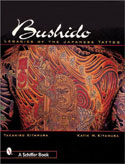|
|
||
|
|
||
 Bushido: Legacies of the Japanese Tattoo
Bushido: Legacies of the Japanese Tattooby Takahiro Kitamura and Katie M. Kitamura.
A tattooist himself, Takahiro Kitamura takes a deep look at the ties between tattooing and samurai ethics in modern Japanese tattoo culture in BUSHIDO. Having associated with tattooist Horiyoshi III both as a tattoo client and student, Kitamura uses many of this master tattoo artistÕs designs to illustrate his theses.
Historically, much of tattoo art comes from woodblock printing and the ukiyo-e artists of the Edo period. Kitamura also looks at how shifting political and religions beliefs during this time effected the public arts and how this in turn shaped tattoo designs. He also touches briefly on the classic Japanese tattoo icons.
The second chapter is very interesting in this is where Takahiro tells of selecting a back tattoo, speaking not only of how this is a major tattoo decision in Japanese tattooing, but telling his own story. Following this is a large section of photos, showing different clients of Horiyoshi III. The photographs are all full-color and show many of the finer tattoo details very clearly and in close-up. Full-color and monochrome tattooing styles are shown, as well as partial and full-body tattoos.
The third chapter addresses how the tattoo business works in Japan and how interactions between artist and client are shaped by bits of ancient honor codes, formal etiquette and lots of self-discipline all around. Even within a culture that is as stylized as JapanÕs, the tattoo segment of that world carries its own rituals and rules. For these reasons, tattooing is still a very underground practice, but the traditional techniques have also survived over many centuries.
In chapter four, having provided enough historical and visual context, the influence of samurai bushido culture on tattooing is explored in depth. The family structure that comes with passing along tattoo traditions is what shapes the modern tradition the most, with histories of the Horiyoshi and Horihito families and their apprentices examined.
The book closes with even more fantastic pictures, a dense bibliography and a wonderful appendix that shows and names all the variations on Japanese tattooed body suits. To me, that appendix alone makes the entire book worth it, as the names for various sleeve lengths and styles of coverage are identified clearly.